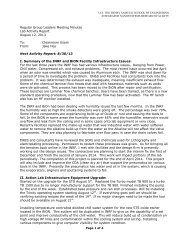Download Lab Safety Manual - Integrated Nanosystems Research ...
Download Lab Safety Manual - Integrated Nanosystems Research ...
Download Lab Safety Manual - Integrated Nanosystems Research ...
You also want an ePaper? Increase the reach of your titles
YUMPU automatically turns print PDFs into web optimized ePapers that Google loves.
Chloroacetic Acid†<br />
Chromic Acid‡<br />
Hydrobromic Acid‡<br />
Hydrobromous Acid<br />
Hydrochloric Acid<br />
Hydrochlorous Acid<br />
Iodic Acid‡<br />
Muriatic Acid<br />
Nitric Acid‡<br />
Nitrous Acid<br />
Perchloric Acid‡<br />
Phenol†<br />
Propionic Acid†<br />
Sulfamic Acid†<br />
Sulfanilic Acid†<br />
Sulfuric Acid‡<br />
Sulfurous Acid<br />
†Indicates organic acids.<br />
‡Indicates strong oxidizing acids.<br />
II.<br />
HYDROFLUORIC ACID<br />
Characteristics • Extremely hazardous<br />
• Highly corrosive acid that attacks silicates such as glass.<br />
Storage<br />
Precautions<br />
Immediate<br />
Action<br />
• Pure hydrofluoric acid dissolves glass, leaving a brilliant, acid-polished surface<br />
• Store in a cool, dry, well-ventilated place away from incompatible materials<br />
• Avoid contact with glass, concrete, metals, water, acids, oxidizers, reducers,<br />
alkalis, combustibles, organics, and ceramics<br />
• Secondary containment trays, constructed of polyethylene are recommended<br />
• Never store in glass containers<br />
Health • Skin contact with hydrofluoric acid may cause severe burns.<br />
• Burns may not manifest immediately at concentrations of less<br />
than 50%.<br />
• Fluoride ions penetrate the skin easily and can cause considerable<br />
damage<br />
• Eye contact can result in destruction or opacification of the cornea<br />
• Blindness may result from severe or untreated exposure,<br />
immediate first aid is necessary<br />
• Concentrated solution and anhydrous hydrofluoric acid produce<br />
pungent fumes on contact with air. These fumes can cause nasal<br />
congestion and bronchitis, even in low concentrations.<br />
• Burns that occur when the vapors or liquid contact the oral mucosa<br />
or upper airway may cause severe swelling, to the point of airway<br />
obstruction<br />
• Mode of action is to bind calcium whenever contact occurs with<br />
skin or other body tissues<br />
• Tissue destruction and neutralization may proceed for days<br />
• Because calcium is necessary for cell life, its binding can bring<br />
about rapid cell death<br />
• If exposure is extensive, excessive amounts of calcium may be<br />
inactivated and adequate supplies of calcium may be unavailable<br />
for vital bodily functions<br />
NOTIFY EH&S OF ANY RELEASE:<br />
• Beyond immediate work area<br />
• Causing personal injury<br />
39



